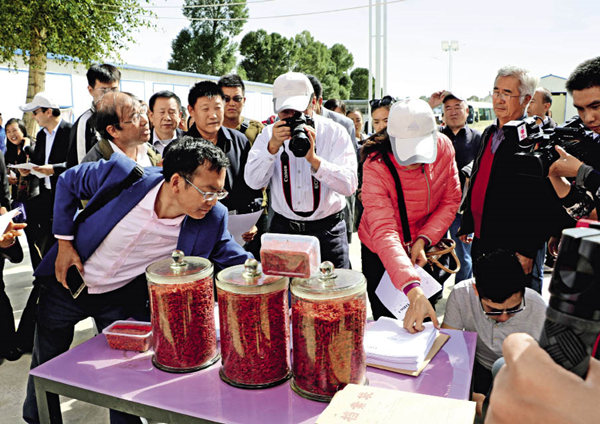Red Berries that Glint in the Desert
China Today by HUANG YUANJUN, December 21, 2016 Adjust font size:
GUIDED by the provincial strategy of building an ecologically strong Qinghai, goji berry cultivation in Haixi Mongolian and Tibetan Autonomous Prefecture has developed in leaps and bounds since 2008. The prefecture’s total plantation area has expanded from a few sporadic patches to more than 27,000 hectares. Haixi is now China’s second largest goji berry growing region. A small fruit has thus promoted a big industry, so adding impetus to local agricultural structural adjustments.

Several new goji berry species cultivated in Haixi in recent years strengthen their market appeal.
Rather than merely focusing on scale and yield, local goji berry industry now seeks better quality and efficiency, according to head of the prefecture’s Institute of Agricultural Sciences Ren Gang.
Millennium-old Goji Berry Forest
Most goji berries grow in the areas of Dulan, Uland, Delingha, Da Qaidam, and Golmud in the Qaidam Basin. Visitors in search of the origins of the local goji berry culture are often directed to a 1,000-year-old wild goji berry forest in Wulonggou. Hidden in Dulan County, it is the largest forest of its kind in the Qaidam Basin.
Wulonggou is situated on the Kunlun Mountains. The name, which literally means “valley of five dragons,” originates in a local legend about five dragons that once guarded the 12 divine trees that stood in the valley.
A surprising quantity of wild goji berries doggedly survive in the valley, on land that has sparse vegetation due to an arid climate. Some trees may grow to a height of two meters, their trunks the girth of an adult’s forearm. However, their fruits are small and scant. Most trees no longer bear fruit, even though their leaves still flourish. Local professionals explained that artificially planted goji berry trees often yield more, and their fruits are plumper. In a bid to make picking easier, the height to which saplings grow is controlled. Yet although wild goji berry trees bear smaller fruits and yield less, they taste much better than those that have been planted.
Wild goji berry trees grow on almost 66,667 hectares of the Qaidam Basin, of which 227 hectares are in Wulonggou. Their natural seeds provide ample gene varieties for cultivating new species. Besides, goji berry trees of more than 200 years old – conspicuously beyond the average age of 35 to 50 years – are still found in the region. And there are also 100 or so trees in Wulonggou that are more than 60 years old. It is said that the forest could have a 1,000-year history.
A hill shaped like a monkey stands among the trees. According to folklore, the Queen Mother of the West, a Taoist goddess who once lived in this area, ordered the monkey to protect the forest. At harvest season, the monkey would offer goji berries as tributes to celestials.
“The Qaidam Basin is one of the native sources of goji berries, and more than 10 wild varieties grow here. Among them, the wild black goji berry is a rare species with a medicinal value far higher than that of other varieties,” said president of the prefecture’s goji berry association and goji berry industry administration Li Jianxin.
Diversified Development Mode
Although the Qaidam Basin is a native source of goji berries, no proper industry formed in the past because only a few small plantations existed in Haixi Prefecture. Since 2008, when the local Haixi government named goji berry-planting as the priority industry for local development, the industry has made remarkable progress.
Generally speaking, Ningxia Hui Autonomous Region dominates today’s domestic goji berry market. Meanwhile, emerging production areas like Xinjiang and Gansu are developing rapidly. In a sense, therefore, Haixi faces great challenges in this market. “That means we must build up a distinct brand image and embrace a diversified development mode,” Ren Gang said.
After spending a week traveling more than 3,000 kilometers in the vast Qaidam Basin, this reporter was deeply impressed with its unique environment that endows local goji berries with their distinct advantages.
The Qinghai-Tibet Plateau interior where Qaidam Basin is situated is acknowledged as one of the cleanest areas in the world. Innocent of industrial pollution, it enjoys clean air, water, and soil. Meantime, a dry climate, long hours of sunshine, and the considerable difference between day and night temperatures provide favorable natural conditions for the local goji berry industry. For instance, the plateau’s chilly, dry climate and ample sunshine help to reduce plant diseases and insect pests. What’s more, the good gas permeability of its sandy soil is ideal for growing goji berry trees. Potassium- and nitrogen-rich soil is another main reason why the quality of goji berries here is remarkably better than in other regions.